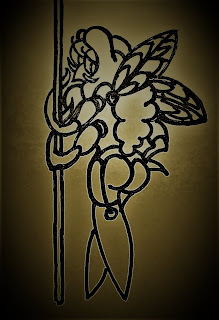I. Re: 26-letter, 5-vowel alphabet (“VV”) in which
letter Y is treated -- initially -- as a consonant.
Disposition
1
If the vowels
of the alphabet as it is known today ("VV")
are seen to line up in
a vertical column when the full
complement of 26 letters is arrayed in rows in
order from
left to right, the beginning portion of the resulting array
appears
as in fig. 1.1:
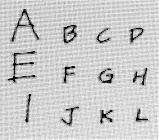 |
| fig. 1.1 |
In order for the next vowel in the sequence, letter O, to
line up directly below the
earlier vowels and thus continue
their columnar alignment, the letters of
consonantal dyad
M/N must interrupt the established pattern and
position to
the left
of letter O -- the subsequent letters reverting to
the earlier patterning, as
appears in fig. 1.2:
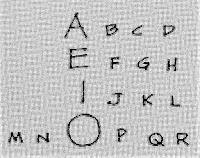 |
| fig. 1.2 |
A similar repositioning occurs when the following two
letters, the
consonantal dyad S/T preceding the vowel U,
are reached, with the
continuing series of letters reverting
once again to the earlier-established
columnar alignment.
The final two letters, the consonantal dyad Y/Z, position
directly below the earlier M/N and S/T dyads, and the
final array appears
as shown in fig. 1.3:
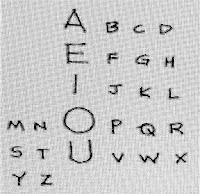 |
| fig. 1.3 |
The resulting array exposes several troubling gaps in an
otherwise nearly
perfect 6x6, 36-letter -- or, rather, a
36-position
-- grid. The flaws in this array, though the
array possesses some positive
characteristics, are clearly
displayed in fig. 1.4:
 |
| fig. 1.4 |
As fig. 1.4 reveals, the array of this first disposition is
asymmetrical and fails to account for fully 10 missing
letters, including,
significantly, a missing vowel. More
importantly, the vertical column of vowels
skews left --
a so-called “progressive tendency” likely to prove
problematical later,
as have such tendencies during past
attempts at alphabetical reform. When
this asymmetry
is corrected by providing additional positions for currently
unrevealed letters -- by providing, in fact, an entirely
new vertical column
positioning to the left of the array
as it appears in fig. 1.4, such
that the vertical vowel
column now appears at the center within
the array --
the resulting array is as appears in fig. 1.5:
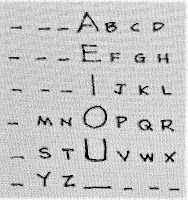 |
| fig. 1.5 |
This adjustment, however, exposes the existence of an
unprecedented 16
missing letters, among them the still
unaccounted for vowel. (It may be helpful
to note here
that an array which posits a six-vowel universe -- i.e.,
one in
which the letter Y is treated as a vowel (the so-
called “VIV” or “Six-Vowel
Universe”) -- reveals a
disposition configured as appears in fig. 1.6:
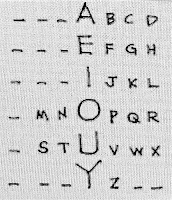 |
| fig. 1.6 |
Although the missing vowel noted in the five-vowel array
is now accounted for
in this new six-vowel array, there do
remain 16 missing letters. Where are
these lost elements?
Why are there so many? No simple answers to
these
questions and others have as yet presented themselves,
but perhaps an
entirely new disposition, if it doesn't posit
some answers, may at least
address the questions.
Disposition 2
In this revisionist disposition, the first nine letters of the
current
alphabet are displayed in a single horizontal row
in order from left to right.
The resulting pattern is beautifully
symmetrical, consisting of a primary triad
disposed in three
monads of vowels (A/E/I) interrupting two triads of consonants
(B/C/D and F/G/H), as is shown in fig. 2.1:
 |
| fig. 2.1 |
If the remaining 17 letters of the current alphabet are positioned
from
left to right in a horizontal row beneath the first row, this
second row also
proves symmetrical, appearing as a kind of
proportional expansion on the
structure of the first row in that
it displays, among other units, two
monads of vowels (O/U)
which are elements, along with three flanking pentads of
consonants (J/K/L/M/N, P/Q/R/S/T and V/W/X/Y/Z), in a
higher-order,
five-element grouping, as is shown in fig. 2.2:
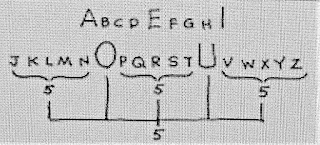 |
| fig. 2.2 |
This second disposition, though its implied 17x2, 34-element
array is
not perfect (critics of a Chomsky persuasion have
suggested it to be
pluperfect, but these have not, in the
final analysis, proven credible – nor
have their theories),
may be considered an improvement over Disposition
1 in
that (a) its construction reveals only eight missing letters
(four on
both the left and right flanks of the top row) -- and
no missing vowels -- and
that (b) it displays a telling series
of parallelisms, as is revealed in figs.
2.3 and 2.4:
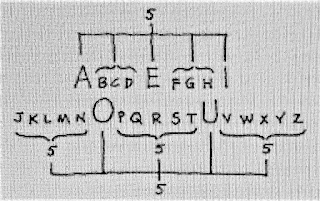 |
| fig. 2.3 |
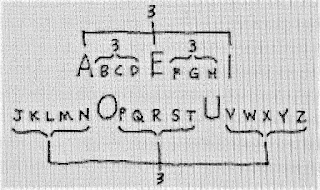 |
| fig. 2.4 |
Of particular note are the pentadic resonances displayed in
fig. 2.3. -- the
lower row consisting of a group of three
consonantal
pentads interrupted by a pair of vowels -- the
O/U dyad -- to form a
higher-order pentad of elements --
the three lower-order pentads and the two
vowels -- and
the upper row consisting of a single pentad composed of the
three vowels and the two triadic consonantal groupings
mentioned earlier -- and the analogous triadic resonances
displayed in fig. 2.4. The
final full disposition appears as in
fig. 2.5:
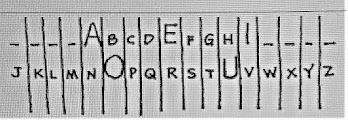 |
| fig. 2.5 |
One improvement over Disposition 1 exhibited by this new
disposition’s
solution are a reduction by half of implied missing
characters, from 16 to
8. But can this disposition be improved
upon even further?
Disposition 3
Returning to a predominantly vertical five-vowel columnar
arrangement, the
characters are arrayed leaving gaps as
space holders to allow a perfect array
to unfold, as is shown
in fig. 3.1:
 |
| fig. 3.1 |
Though the left-leaning tendency of the now vertical column
of vowels
(resulting from the abandonment of the centered
vertical column of vowels,
regardless of the number of
characters) continues problematical, the
overall order displayed
is commendable. Still, there do remain the four
missing
elements. What are they? Where have they gone? The latter
question may
be unanswerable at present. As to the former,
they must prove to
be new graphic signs, possibly representative
of new sounds. What new
sounds they might represent, and
whether those sounds might be vowels (an
eventuality which
would call for an entirely new disposition) or consonants --
this
question, too, may be at present unanswerable. But more than
a few
candidates offer themselves for consideration as
representatives of these new
signs. One solution is to create
these new letterforms from graphic materials
already provided
by the so-called central vowels -- i.e., the second, third and
fourth vowels (E, I and O) -- namely, the circle, the vertical
stroke and the
series of horizontal strokes. Fig. 3.2 displays
several examples from
possibilities employing these materials:
 |
| fig. 3.2 |
Inserting these new graphics into the spaces provided yields a
new
alphabet -- a 30-letter array (five vowels, 25 consonants)
disposed in a 6x5
grid appearing as in fig. 3.3:
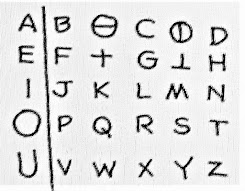 |
| fig. 3.3 |
But, as mentioned earlier, the names and the sounds of these
letters, and any
others like them, remain yet to be determined.
II. Re: 24-letter, 6-vowel alphabet (“VIV”) in which
Y is treated
as a vowel.
Disposition 4
Continuing to anticipate that, as the letters are disposed in
horizontal rows
in order from left to right, the vowels will align
themselves in a vertical
column, the newest disposition appears
as in fig. 4.1:
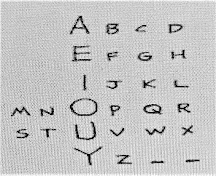 |
| fig. 4.1 |
The consonantal dyad M/N then moves from its original position
in that
array (fig. 4.1) to the vacant spaces at the end of the last
row of the array
created by the exhausting of the letter sequence
of the original alphabet, as
in fig. 4.2:
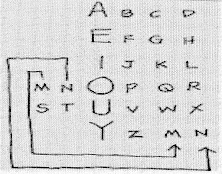 |
| fig. 4.2 |
The consonantal dyad S/T similarly repositions to spaces left
vacant in an
implicit seventh row, leaving space for an implied
vowel to position beneath
the vowel column. This disposition
appears as in fig. 4.3:
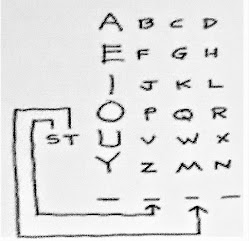 |
| fig. 4.3 |
One procedure for avoiding the necessity of creating for the
new
seventh row several additional new letters (or, alternatively,
of
discovering lost ones) -- letters voiced with new sounds and
employing new orthographical functions -- is to
eliminate
entirely this newly created row in which the consonantal dyad
S/T currently positions. Spaces in which to insert the S and
the
T can be located within the array -- e.g., the functions of
letter F can be performed by the PH letter combination, thus
allowing the
elimination of letter F and the replacement of it
by letter S. Further,
the functions of letter J can be performed
by the letter I, thus allowing the
elimination of letter J and the
replacement of it by the letter T. Eliminating
these two letters
and replacing them with S and T reveals an array as is shown
in figs. 4.4 and 4.5:
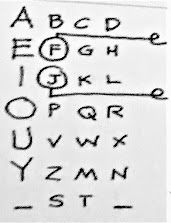 |
| fig. 4.4 |
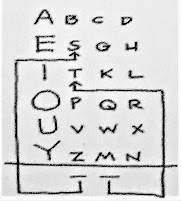 |
| fig. 4.5 |
This new array displays a 4-row, 6-column, 6-vowel, 24-letter
alphabet
(the vowels are in boldface) and a set of mnemonics
useful in committing to
memory the new letter sequence for
all familiar with the early
sing-song rhyme (researchers are
currently developing a new sing-song rhyme
using these
mnemonics to replace the old):
A B C D = ("Cab D")
E S G
H = ("Sheg")
I T
K L = ("Klit")
O P Q R = ("Porq")
U V W X = (" Wu15")
Y Z M N = ("Mynz")
This new
alphabet provides all the functionality of the current
26-letter version --
and, perhaps more importantly, displays
a very attractive regularity. As the
positive and negative
aspects of each of these dispositions continue to be
reviewed
and evaluated, an examination of the alphabet from an entirely
new
perspective, that of its characters’ graphic shapes, may
prove timely.
III. Re: 26-letter, 7-vowel alphabet (“VIIV”)
-- a digression
Disposition 5
Using the five fingers of the left hand (amputees and readers
repelled by
shameless puns are advised to disregard this digression)
as a kind of “digital”
computer, and disposing the traditional
26-character alphabet in a continuing
sequence vertically into
five-unit subgroup columns, retaining the first
letter in each
5-character column and eliminating from consideration letters
two
through five in each column, an alphabet is created which
possesses a new
order, as is shown in the figure below:
(additional figures to come: a work in progress)
Note the
regular -- almost! -- distribution of vowels in this
disposition. No vowels
appear in the second half of the alphabet;
all appear in the first half.
In fact, every second character in the
first half is a vowel, the single
anomaly being the letter K
within this so-called left vowel
hemisphere. The arguably inevitable
conclusion -- that K is a vowel -- has been
disavowed (disavoweled?)
by a narrow but not insignificant majority of
responsible critics,
while the researcher originally drawing this conclusion,
along with
all supporters, has been, not inappropriately, disemvowled.
It must be noted, by the way, what has not gone unnoticed by
many
researchers: That this disposition is capable, prior to the
elimination of expendable letters in the lower columns below the
retained
alphabet, of doing double duty as a word search game,
four from among a host of
solutions to which (i.e., ‘chins,’ ‘snide,’
‘snot’ and ‘swag,’) are indicated
by the figs. below. The overall
theme for such a search (if it exists) remains
undetermined.
Any
further inferences to be drawn from this digression must be
postponed for the
time being.
IV. Re: 13-letter (5 vowels, 7
consonants) alphabet: An Inconvenient
Futh (an “IF” and/or a
"butt")?
What about an alphabet designed, rendered and organized based
on the
shapes of its component letterforms? What might be the
advantages and pitfalls
of such an alphabet?
First, some preliminary observations.
There are, in the current 26-letter alphabet, a multiciplity of stroke
characteristics exhibited. Strokes can be seen as straight or
curved.
Straight strokes can be seen as vertical, horizontal or diagonal.
Regarding characters with multiple straight strokes, the strokes
can be of a
single quality (i.e., vertical only, diagonal only, etc.)
or be
composed of strokes of more than one quality (i.e., vertical
and
horizontal, vertical and diagonal, etc.). (Imagined characters,
exhibiting the
qualities indicated in the various column headings
but not appearing in
the current 26-character alphabet, appear in
shaded boxes. The letter
M may appear in either of two categories.)
Further, there are, in the current 26-letter alphabet, a multiplicity
of
symmetries exhibited.
4.1 The Five Strōkularities of the IF, consisting of:
4.1a: The Fifteen Invariants:
I. The Four Pure
Diagonoids or Diagonoid Only (diag. I)*
{X, M, W, V}
II. The Five
InvariBlends or Diagonoid + Horivert (diag. II)
{Z, A,Y, K, N}
III. The Six Pure
Horiverts or Horivert Only (diag. III)
{T, I, L, F, H, E}
* M and its invert W are
together herein treated as
diagonoids, even though occasionally their graphs,
as expressed
in one or another particular typeface, do not consist strictly of
pure diagonoid elements. The abbreviation ’diag.,’ of course,
designates the
various diagrams below and is not to be confused
with the diagonoids.
and 4.1b: The Eleven Arciformants:
IV. The Eight ArciBlends
or Mixed Arci/Invar (diag. IV)
{G, Q, R, B, D, P, J, U}
V. The Three Pure Arciformants
(diag. V) {S, O, C}
4.2 The Seven Symmetricals:
4.2a The Omnisymmetrical
(The “O” Subgroup)
4.2b The Duplasymmetrical
(The “HOXI” Subgroup)
4.2c The Vertisymmetrical
(The so-called
"Hoxi/ViewMyWat" -- “HOXI/VUMYWAT" Subgroup)
4.2d The Horizometrical
(The so-called
“Hoxi/DavidBeckham” -- “HOXI/DBECK” Subgroup)
4.2e The Diagometrical
(The so-called “Cream
Cheese” -- “LOX” subgroup)
4.2f The Diag/Revertrical
(The so-called
“Hoxi/Achoo!” (“Ox/SNeeZe”) Subgroup)
4.2g The NoNoNometrical
(The so-called “FaGs
& JaPs & QueeRs” -- “FG/JP/QR”
Subgroup)
4.3 A Sidebar: Quartal and Octal Torque
4.4 The “Thweet Thirteens”
4.5 The Thweetest Thirteen:
ABC = CAB; DEF =
FED; MJONUZY = NYJUZOM; or,
Cab Fed Mo' NY Juz!
an Inconvenient Futh
A B C
D E F M J
O N U Z Y
C A B
/ F E D
/ M U J O /
Z Y N
(to be continued; a work in progress;
explanatory figures will be inserted soon)
